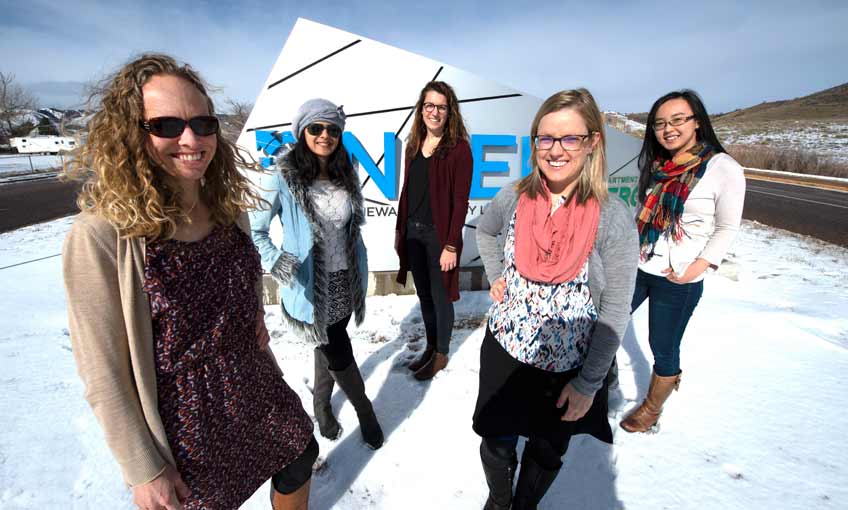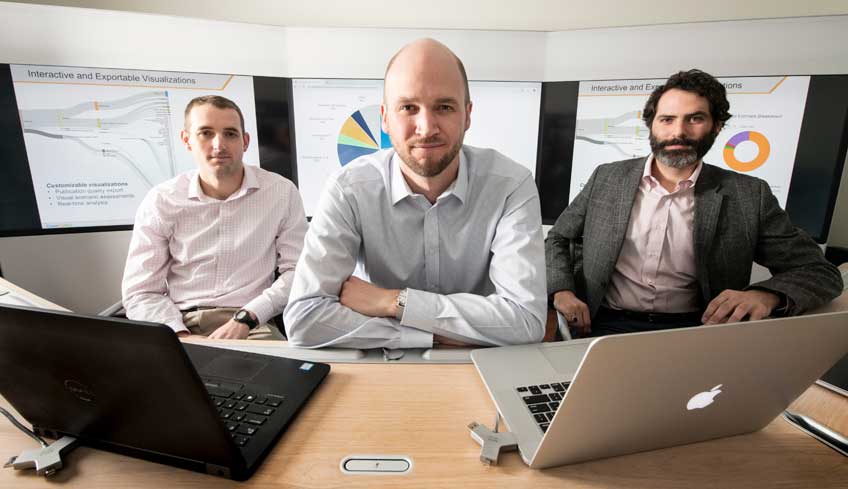Virtual Tools Developed at NREL Create Real-World Savings

Josh Schaidle wants an answer from college chemistry and engineering students when he visits their classrooms: How much does a catalyst cost?
“That's the first question, and you don't get a lot of answers initially,” said Schaidle, a chemical engineer in the National Bioenergy Center at the U.S. Department of Energy's (DOE's) National Renewable Energy Laboratory (NREL) and director of the NREL-led Chemical Catalysis for Bioenergy Consortium (ChemCatBio).
But considering the price tag of a chemical catalyst manufacturing process, or the cost of deploying solar panels, or even the savings energy efficient buildings can generate are increasingly important functions of NREL research.
That's why Schaidle and his NREL colleagues are creating useful software applications designed to help highlight potential costs and savings. In doing so, they hope to shorten the path to commercialization and increase overall adoption of renewable energy and energy-efficiency technologies.
Here are a few recent examples of this effort.
In collaboration with Pacific Northwest National Laboratory through ChemCatBio, Schaidle and his team developed a free program called CatCost, designed to estimate the costs associated with manufacturing different types of catalysts. “This is not a money-making opportunity,” Schaidle said. “We're sharing knowledge broadly with the catalysis community and enabling them to accelerate their research.”
The idea behind CatCost was sparked about four years ago by the realization that virtually no public information was available for estimating the costs of pre-commercial catalysts. Schaidle said he and his colleagues were trying to develop a better, cheaper way to convert biomass into liquid transportation fuels. That required choosing the right catalyst.
“We were looking at all these different catalytic materials,” Schaidle said. “Some we knew were pretty expensive, like platinum. Others used less-expensive metals but were being synthesized using fairly exotic methods. We sat there and we said, “We're starting to assess the performance of these catalysts, we're putting them in a reactor, we're studying them, but we have no knowledge of how much these materials are going to cost.”

Not only does CatCost draw from a continually updated database of the price of raw materials, it also considers the cost to manufacture a catalyst. It's not enough to say that platinum is an expensive raw material or that nickel isn't. “In reality, sometimes the synthesis steps—the actual processing steps—can contribute a reasonable amount to the overall costs of the catalysts,” Schaidle said.
CatCost also features a spent catalyst reclamation module. “If you're using platinum as a catalyst and you finish running the catalyst in a reactor and it's basically spent, are you going to toss it? Of course not,” Schaidle added. “You're going to put a lot of time and effort into recovering that platinum. The tool takes that into account. It uses decision logic to evaluate when you should recover valuable metals from a spent catalyst, including how to do that and the costs associated with that.”
CatCost offers users the choice of a web-based application or a spreadsheet. Both have the same functionality, although the online version comes with interactive visualizations.
Schaidle said CatCost has been widely used since its release, and he's fielded calls from companies large and small. “A few larger corporations have said this tool has specifically improved their research efficiency,” he reported.
REopt Lite
Please contact the Webmaster if you need assistance with this video.
NREL's REopt software analyzes the cost-effectiveness of deploying solar panels on commercial properties, and has been used to assess energy optimization opportunities for more than 10,000 sites. But it's an internal tool that only “10–15 people at NREL know how to use it,” said Kate Anderson, program manager for the REopt Lite development team. “It's primarily used to provide analysis services to our partners.”
Enter REopt Lite, which emerged from beta testing last fall. “The Lite version includes about 10% of what's in REopt,” Anderson said. “We chose the most-used features, the most tried and true, so we felt confident making them available in a public version. By making REopt Lite open, accessible, and free to the public, we're hoping to increase the impact of it, which to us means increasing deployment of clean-energy projects. So far we have about 8,000 users and over a million hits to the application program interface.”
REopt Lite relies on a series of default data sets. Users have the choice of 76 inputs—but only need three for a preliminary analysis. It's as simple as entering an address, selecting the utility rate from a drop-down menu, and choosing the type of building. Based on this information, REopt Lite provides a recommended system size and dispatch strategy to minimize the building's cost of energy. The tool also estimates how long the recommended system can sustain the site's critical load in the event of a grid outage.
Initially, the software only considered the cost-effectiveness of solar and energy storage for a site, but updates added the possibility of drawing power from wind turbines and designing systems for resilience.
“We're continuing to add new capabilities to it,” Anderson said. “We get a lot of input from users, as well as our advisory board, for additional capabilities or ways to improve it.”
Upcoming changes include the addition of combined heat and power systems and making REopt Lite open source. According to Anderson, “Open sourcing it will allow software developers to integrate the code into their tools and programs, hopefully increasing the impact of it.”
ResStock

While REopt Lite is for commercial properties, ResStock is designed to provide information applicable to entire neighborhoods or communities. The energy analysis tool also scales to states, utilities, regions, and the entire country
“We've seen a lot of excitement from basically everybody we talk to,” said Eric Wilson, a senior research engineer at NREL. “Every couple of weeks I have conversations with states or cities or manufacturers who are interested in using it in some way or another.”
ResStock builds on decades of NREL building-efficiency research. More than a dozen different data sources power ResStock's ability to analyze how changing one parameter could increase energy efficiency and thus bring down costs. It considers inputs from individual homes including the era when it was built, how much insulation is in its attic and walls, square feet, what type of heating and cooling systems are used, and how efficient those systems are. The application has enough data to analyze communities across the United States, save for Alaska and Hawaii where the sample sizes are too small.
The types of ResStock users vary. A manufacturer, for example, might find it useful to determine whether to develop a new type of water heater or air conditioner. “It's part of market research,” Wilson said. “It can help companies understand the total potential revenue.”
Likewise, cities are finding ResStock useful in determining how the potential for energy-efficiency opportunities and related costs. They could ask, for example, “What upgrades to the building stock are cost-effective without incentives—and which upgrades may need some incentives to spur people to make changes? Cities are also really interested in making sure any action they take on their energy or climate goals benefit low-income households,” Wilson explained.
PRECISE
Please contact the Webmaster if you need assistance with this video.
Utilities are the intended users for another NREL-developed tool, called PRECISE. The acronym stands for Preconfiguring and Controlling Inverter Set-Points. Developed with the Sacramento Municipal Utility District, PRECISE allows utilities greater control over residential inverters (which change the direct current output of solar panels to alternating current for use by household appliances), allowing them to maximize the cost-effective use of the panels.
With PRECISE, utilities can also identify the best and safest operating conditions for new solar energy systems. The automated software eliminates guesswork, and can even help utilities determine how to customize inverter settings to provide a balance between grid stability and customer savings.

For example, when a customer asks for approval to install solar panels on the roof of their house, the utility can use PRECISE to input the location and size of the requested system and find out the optimal settings for the system's inverter. “You can set it and forget it,” said Adarsh Nagarajan, an NREL engineer and principal investigator on the project. “With the optimal setting, a solar panel that comes close to topping the utility's safe voltage limits can be automatically triggered to produce less power.”
Now in use in parts of California, the open-source tool will soon be tried out in India. “Any utility can use this,” Nagarajan said. “PRECISE will reduce interconnection time by 50%. It's going to be time-efficient—cost-efficient for sure.”
Learn more by visiting the websites for CatCost, REopt Lite, ResStock, and PRECISE.
Last Updated May 28, 2025
